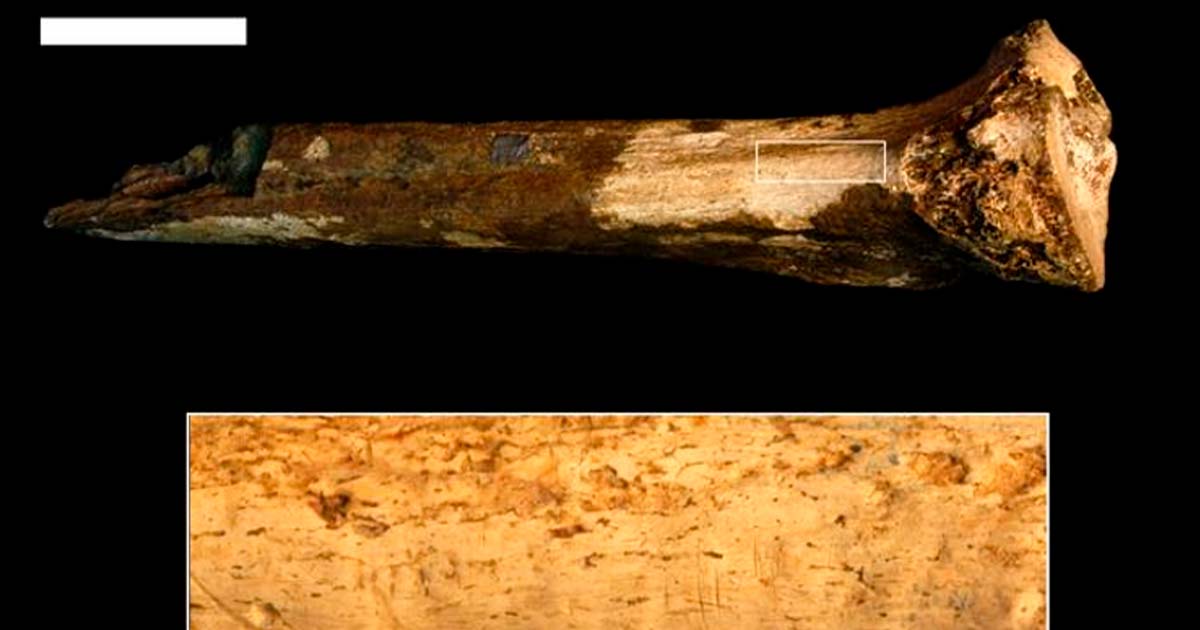A human leg bone dating back to 1.45 million years ago is marked with 11 tiny cut marks. A new study shows that while two were made by an animal, probably a lion, the remaining 9 suggest another human butchered and ate the flesh.

A study published in Scientific Reports says the human tibia, marked with cuts, “belonged to a mystery human relative” who used to live in what is now an archaeological site in Koobi Fora, Kenya, Africa. The researchers write that the bone may represent “the oldest example we’ve seen yet of hominin-on-hominin butchery.”
Hominin-On-Hominin Dining?
Team leader, paleoanthropologist Briana Pobiner of the Smithsonian Institution’s National Museum of Natural History, has performed a 3D analysis of the 11 cuts on the leg bone. Her findings demonstrate that the marks were caused by sharp stone tools “stripping flesh in preparation for eating.” In the Smithsonian Museum release, Pobiner said the find suggests “hominins were likely eating other hominins at least 1.45 million years ago.”

Cut marks discovered on bones indicate they were worked with tools ready for eating. (Briana Pobiner/ Smithsonian National Museum of Natural History)
In a new study published in Science Alert last year, Professor Pobiner concluded that over the last couple of million years, humans, and our ancestors, occupied a prime position on the food chain. However, numerous species on the human evolutionary tree fed on each other as “a source of nutrition.” But this leg bone suggests human relatives were “eating each other to survive further into the past than we recognized” according to the study.
Prehistoric Cannibalization
Cut marks on human bones can have various explanations, for example, in forensic science they can indicate dismemberment or attempts to conceal evidence. However, in an archaeological context they suggest butchery for consumption, or ritualistic activities. In any context, cut marks on bones offer valuable insights into ancient diets, customs, and people’s relationships with each other and the environment.
In ritual contexts, bones were often carved and marked while interring the dead. An article on Earth.com says human bones were often carved into “decorative objects, such as combs, pendants, and other jewellery.” However, in this instance the marks on the bones have been associated with anthropophagy, which is the eating of human flesh by other humans.
Headlines Are Shouting Cannibalism. But Is It Really?
Ancient cannibalism, according to Dr. Pobiner, is not easy to prove. This means, without supporting evidence, the original reason ‘why’ the bone was carved could easily be misinterpreted. To get around this, using dental molding material, Pobiner recreated the leg bone and sent it to paleoanthropologist Michael Pante of Colorado State University for his opinion. Pante performed a comparative analysis against a database of “898 tooth, trample, and cut marks.”
Pante’s study found that of the 11 marks on the bone, two were caused by animal’s teeth, possibly a lion, and the other 9 were made by stone tools in a chopping manner. Pobiner writes that the 9 marks are consistent with “those made by removing flesh from a bone, for example, in preparation for eating.”
The marks are all located where the calf muscle attaches to the bone. And because all the marks are orientated in a similar direction, they were most probably all created at one time. Dr. Pobiner concluded that it seems ‘most likely’ that the meat from this leg “was eaten for nutrition as opposed to for a ritual”. Of course, this seems the most likely reason, but not a certainty as yet.
While the bone was studied in the 1970s and believed to be “Australopithecus boisei” in the 1990s it was recategorized as Homo erectus. However, the new study says insufficient data exists to make this identification with any confidence and as of now it is still unclear who was eaten, and who did the eating.
Top image: View of the hominin tibia from Koobi For a, with magnified area that shows cut marks that are evidence of possible prehistoric cannibalism. Source: Jennifer Clark/Smithsonian





